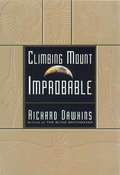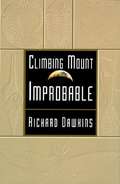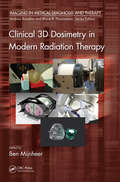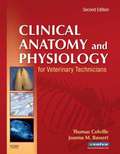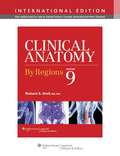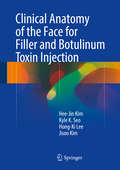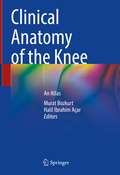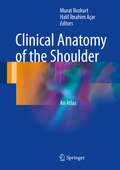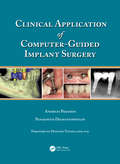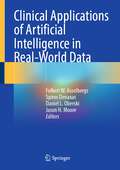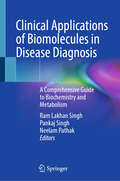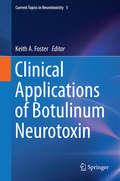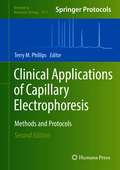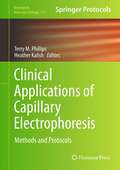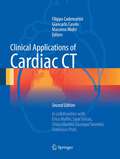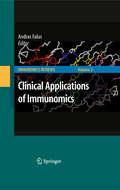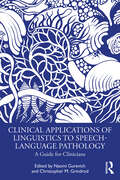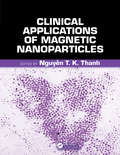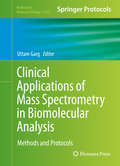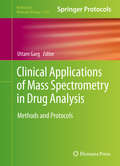- Table View
- List View
Climbing Mount Improbable
by Richard Dawkins Lalla WardA brilliant book celebrating improbability as the engine that drives life, by the acclaimed author of The Selfish Gene and The Blind Watchmaker. The human eye is so complex and works so precisely that surely, one might believe, its current shape and function must be the product of design. How could such an intricate object have come about by chance? Tackling this subject--in writing that the New York Times called "a masterpiece"--Richard Dawkins builds a carefully reasoned and lovingly illustrated argument for evolutionary adaptation as the mechanism for life on earth. The metaphor of Mount Improbable represents the combination of perfection and improbability that is epitomized in the seemingly "designed" complexity of living things. Dawkins skillfully guides the reader on a breathtaking journey through the mountain's passes and up its many peaks to demonstrate that following the improbable path to perfection takes time. Evocative illustrations accompany Dawkins's eloquent descriptions of extraordinary adaptations such as the teeming populations of figs, the intricate silken world of spiders, and the evolution of wings on the bodies of flightless animals. And through it all runs the thread of DNA, the molecule of life, responsible for its own destiny on an unending pilgrimage through time. Climbing Mount Improbable is a book of great impact and skill, written by the most prominent Darwinian of our age.
Climbing Mount Improbable
by Richard DawkinsIt's a treat when a scientist is able to convey the significance of a subject while at the same time commanding a reader's attention with intelligence, wit, and style. Dawkins (Chair, Public Understanding of Science, Oxford U.) manages to make the evolutionary design of animal and insect life both a source of serious biological inquiry and one of miraculous discovery. He portrays the silky worlds of spiders, how wings sprouted on previously flightless animals, the evolution of the human eye (no less than 40 leaps), and details how DNA paves the way for change across the whole spectrum of flying, swimming, and walking creatures. Annotation c. by Book News, Inc., Portland, Or.
Clinical 3D Dosimetry in Modern Radiation Therapy (Imaging in Medical Diagnosis and Therapy)
by Ben MijnheerThis book provides a first comprehensive summary of the basic principles, instrumentation, methods, and clinical applications of three-dimensional dosimetry in modern radiation therapy treatment. The presentation reflects the major growth in the field as a result of the widespread use of more sophisticated radiotherapy approaches such as intensity-modulated radiation therapy and proton therapy, which require new 3D dosimetric techniques to determine very accurately the dose distribution. It is intended as an essential guide for those involved in the design and implementation of new treatment technology and its application in advanced radiation therapy, and will enable these readers to select the most suitable equipment and methods for their application. Chapters include numerical data, examples, and case studies.
Clinical Ambulatory Anesthesia
by Johan RaederAmbulatory care can be a challenging setting in which to provide anesthesia - not all patients are suitable for rapid discharge post-operatively and opinions differ as to which types of surgery should be performed as day cases. This comprehensive guide delivers up-to-date, evidence-based advice on how to provide optimal anesthesia care for ambulatory surgery. Written by a leading clinical anesthesiologist, it provides clear guidance about how to handle particular patients in particular situations. The evidence and scientific knowledge for each issue are presented with reference to major studies and review papers, followed by practical advice based on the author's continuous clinical and scientific experience over 30 years. Topics include planning, equipping and staffing ambulatory units, pharmacology, basic concepts of ambulatory care, pre- and post-operative issues and current controversies. Clinical Ambulatory Anesthesia is essential reading for the clinical, postgraduate anesthesiologist as well as nurse anesthetists involved with ambulatory care.
Clinical Anatomy and Physiology for Veterinary Technicians (2nd Edition)
by Joanna M. Bassert Thomas ColvilleExamine the diverse ways animal bodies function at both the systemic and cellular levels with this vital resource. It brings you clear coverage essential to understanding the clinical relevance of anatomical and physiological principles. Fully updated and written by respected veterinary technician educators, this popular textbook is the practical, comprehensive foundation for your success in veterinary technology. Clinical application boxes help you sharpen your skills and apply principles to practice. Test Yourself boxes throughout chapters emphasize important study points. An extensive glossary provides quick reference to hundreds of important terms and definitions. Over 300 new illustrations help you identify structures with rich, realistic clarity. A NEW full color format visually enhances your understanding of anatomic and physiologic concepts. Four NEW chapters give you the latest insight on the chemical basis of life, nutrition and metabolism, pregnancy, development, and lactation, and reptile and amphibian anatomy and physiology. A revised chapter on the cardiovascular system helps you most effectively comprehend the complex functions of the heart and blood vessels.
Clinical Anatomy by Regions
by Richard S. SnellThis book provides medical students, dental students, allied health students, and nursing students with a basic knowl¬edge of anatomy that is clinically relevant.
Clinical Anatomy of the Face for Filler and Botulinum Toxin Injection
by Hee-Jin Kim Jisoo Kim Kyle K. Seo Hong-Ki LeeThis book, containing more than 200 cadaveric photos and 200 illustrations, aims to familiarize physicians practicing botulinum toxin type A (BoT-A) and filler injection with the anatomy of the facial mimetic muscles, vessels, and soft tissues in order to enable them to achieve optimum cosmetic results while avoiding possible adverse events. Anatomic considerations of importance when administering BoT-A and fillers are identified and in addition invaluable clinical guidelines are provided, highlighting, for example, the preferred injection points for BoT-A and the adequate depth of filler injection. Unique insights are also offered into the differences between Asians and Caucasians with regard to relevant anatomy. The contributing authors include an anatomist who offers distinctive anatomic perspectives on BoT-A and filler treatments and three expert physicians from different specialties, namely a dermatologist, a plastic surgeon, and a cosmetic physician, who share insights gained during extensive clinical experience in the use of BoT-A and fillers.
Clinical Anatomy of the Knee: An Atlas
by Murat Bozkurt Halil İbrahim AçarThis book provides detailed information on functional anatomy, physical examination, and clinical radiology of the knee with a view to enabling the clinician to identify the most suitable treatment approach to different knee joint pathologies. In addition, the arthroscopic treatment techniques most frequently employed in patients with these conditions are described, with presentation of numerous arthroscopic images detailing characteristic findings. Knee joint pathologies today represent a significant challenge owing to the complexity of the injuries suffered, rising activity levels, and high patient expectations. A proper physical examination plays an important role in diagnosis. The surgeon who has the opportunity to conduct a clinical evaluation must fully understand the role of radiological evaluations, and assessment by a radiology expert is also necessary. In all cases, knowledge of the normal anatomy and its correlation with clinical and radiological findings is fundamental to correct diagnosis and treatment selection. Surgeons and trainees with an interest in knee joint pathologies will find this book to be an excellent, richly illustrated educational guide to the subject.
Clinical Anatomy of the Shoulder: An Atlas
by Murat Bozkurt Halil İbrahim AçarThis book provides detailed information on functional anatomy, physical examination, and clinical radiology of the shoulder with a view to enabling the clinician to identify the most suitable treatment approach to different shoulder joint pathologies. In addition, it describes the arthroscopic treatment techniques most frequently employed in patients with these conditions and presents numerous arthroscopic images detailing characteristic findings. The shoulder is widely regarded as the most complex joint in the human body, displaying the widest range of motion. Knowledge of normal and pathological anatomy, ability to perform a proper physical examination, and appropriate selection of imaging modalities and interpretation of imaging appearances, often in close collaboration with an imaging expert, are all vital for correct diagnosis and choice of treatment approach. Surgeons and trainees will find this richly illustrated book to be an excellent educational guide and an instructive source of stepwise guidance from clinical presentation to achievement of desired treatment outcomes.
Clinical Application of Computer-Guided Implant Surgery
by Andreas Parashis Panagiotis DiamantopoulosStep-by-Step, Color Presentation of CGIP in Everyday Clinical PracticeComputer-guided implant placement (CGIP) helps clinicians precisely implement a treatment plan and accurately place implants with the use of three-dimensional interactive imaging software. The software enables the direct link between anatomic interpretation, surgical and prosthet
Clinical Applications of Artificial Intelligence in Real-World Data
by Jason H. Moore Folkert W. Asselbergs Spiros Denaxas Daniel L. OberskiThis book is a thorough and comprehensive guide to the use of modern data science within health care. Critical to this is the use of big data and its analytical potential to obtain clinical insight into issues that would otherwise have been missed and is central to the application of artificial intelligence. It therefore has numerous uses from diagnosis to treatment. Clinical Applications of Artificial Intelligence in Real-World Data is a critical resource for anyone interested in the use and application of data science within medicine, whether that be researchers in medical data science or clinicians looking for insight into the use of these techniques.
Clinical Applications of Biomolecules in Disease Diagnosis: A Comprehensive Guide to Biochemistry and Metabolism
by Ram Lakhan Singh Pankaj Singh Neelam PathakThis textbook introduces the clinical applications of biomolecules in disease diagnosis, covering a range of topics in biochemistry. The book discusses carbohydrate and protein metabolism abnormalities, lipid digestion and absorption defects, disorders of purine and pyrimidine metabolism, and the chemistry and biological roles of water- and fat-soluble vitamins. It also covers the roles of different macroelements and essential trace elements in physiological processes and the prevention of chronic diseases. The final chapter focuses on recent developments in our understanding of the role of enzymes in disease development and diagnosis. The book chapter also explores the causes and effects of free radicals in the body, including oxidative stress and diseases such as cardiovascular and neurodegenerative diseases. Finally, the chapter discusses cancer development, causes, diagnosis methods, biomarkers, and current treatments such as targeted drug therapy, chemotherapy, and radiation therapy. This book is a useful resource for undergraduate and postgraduate students, researchers and practitioners in biochemistry, medicine, and health sciences.
Clinical Applications of Botulinum Neurotoxin (Current Topics in Neurotoxicity #5)
by Keith A. FosterCurrently, there are tremendous advances being made in understanding the basic science of both the structure and function of botulinum neurotoxins. This knowledge is opening up opportunities in regard to both therapeutic uses and treatment and protection options for civil and bio-defense applications. This volume fully evaluates the status of neurotoxin research and exploitation. The book is a multi-authored collection of chapters written by the leading authorities responsible for the current scientific and clinical research that is advancing the understanding and exploitation of the neurotoxins and is both up to date and authoritative.
Clinical Applications of Capillary Electrophoresis: Methods and Protocols (Methods in Molecular Biology #1972)
by Terry M. PhillipsThis second edition volume provides a valuable source of information on the application of capillary electrophoresis (CE) and the many different aspects of clinical medicine. Chapters divided into seven parts focus on applications in clinical chemistry and small molecule analysis, applications in drug analysis, examples of CE applied to metabolomics, application in pediatrics, CE analysis on oncology, and CE analysis in virology. Written in the highly successful Methods in Molecular Biology series format, chapters include introductions to their respective topics, lists of the necessary materials and reagents, step-by-step, readily reproducible laboratory protocols, and tips on troubleshooting and avoiding known pitfalls.Authoritative and cutting-edge, Clinical Applications of Capillary Electrophoresis: Methods and Protocols, Second Edition aims to become a resource not only for clinical chemists, but also physicians and scientists who wish to apply these techniques to diagnosis and clinical research.
Clinical Applications of Capillary Electrophoresis: Methods and Protocols (Methods in Molecular Biology #919)
by Terry M. Phillips Heather KalishCapillary electrophoresis (CE) is a powerful and rapid tool for performing complex analyses of a number of different molecular species ranging from small inorganic ions to large nucleic acid fragments and proteins. It is quickly becoming established as a useful tool in clinical medicine due to its consumption of minute samples (less than a microlitre), low reagent costs, and extreme sensitivity, depending upon the source of detection used. Clinical Applications of Capillary Electrophoresis aims to give an in-depth manual of CE applications in several important areas of clinical science. Divided into seven sections, this volume provides a brief overview of how CE has been applied in clinical settings, followed by several chapters on CE analysis of important diagnostic molecules and biofluids, as well as descriptions of applications in clinical chemistry, hematology, bacteriology, virology, disease-associated biomarker discovery, immunology and genetic analysis. Written in the successful Methods in Molecular BiologyTM series format, chapters include introductions to their respective topics, lists of the necessary materials and reagents, step-by-step, readily reproducible protocols, and notes on troubleshooting and avoiding known pitfalls. Authoritative and easily accessible, Clinical Applications of Capillary Electrophoresis seeks to serve as a valuable source of information not only for clinical pathologists, but also clinical scientists who wish to apply the technique to diagnosis and research.
Clinical Applications of Cardiac CT
by Massimo Midiri Filippo Cademartiri Giancarlo CasoloDuring the past few years, cardiac CT (CCT) has acquired an increasingly important role as a noninvasive imaging method that allows assessment of coronary heart disease from both the morphological and the functional standpoint. It is quickly becoming a primary clinical tool for the evaluation and follow-up of various conditions related to the heart and great vessels and is providing valuable insights into the natural history of atherosclerosis. The rapid advances in CCT technology, the advent of new clinical applications, and the acquisition of data on prognostic value are just some of the reasons for the publication of this new edition of Clinical Applications of Cardiac CT, little more than 3 years after the first edition appeared. The text has been extensively revised and updated to reflect current knowledge and practice, and the structure and layout of the educational content have also been improved. The imaging targets, semeiology, technique, and clinical applications of CCT are all covered in detail, and in addition relevant information is provided on epidemiology, clinical assessment, and the role of other diagnostic modalities. This book will prove an invaluable tool for radiologists and cardiologists alike.
Clinical Applications of Human Anatomy and Physiology for Healthcare Professionals
by Jassin JouriaAnatomy and Physiology is effectively a broad introductory course that requires the student to devote an enormous amount of effort to understand it on even a basic level. While this necessitates time, it can be streamlined in the early stages of one’s learning so that the student may understand why he or she is required to invest such a large amount of time into learning - Clinical Applications of Human Anatomy & Physiology is the textbook that accomplishes this.°Clinical Applications of Human Anatomy & Physiology is a book that combines both areas of knowledge for a full comprehension of the human body. It is targeted to healthcare students in need of a better understanding of human physiology to combine with their clinical training. The main objective of this book is to elucidate the organization and functioning of the major organs and systems with an emphasis on the applications of this knowledge on the daily clinical routine.°One of the main differences of this textbook that sets it apart from others is that it not only provides the information: it also contextualizes it. Every chapter starts introducing a case study that is related to the content that is going to be approached. At the end of the chapter, there is the conclusion of each case study, which presents the final diagnosis showing every step of the process. This context is essential so that, when the student faces this situation in the real-life clinic he or she will be able to deal with it efficiently. Clinical Applications of Human Anatomy & Physiology also has sections of questions to practice the knowledge that was obtained during the chapter, and the answers to each question are explained so no doubts remain after studying. All of this means that Clinical Applications of Human Anatomy & Physiology is a fully rounded book that combines information and practical applications, as well as questions that help the student to understand and retain all the information in a very efficient and effective way. This book has all the information you need to get started on your journey to learning about the human body.
Clinical Applications of Immunomics (Immunomics Reviews: #2)
by Andras FalusThis is the second volume in a series that will be dedicated to publishing advances in immunomics particularly those focusing on systemic and integrative approaches in basic and clinical immunology, immunoinformatics, and immunologically relevant instrumentation and high-throughput screening methods. Rapid improvement in accessibility to molecular databases as well as availability of high throughput genomic, proteomic, and other 'omics' methodologies are forcing a considerable shift in research and development strategies for biomedicine. Systems biology, a systematic study of complex interactions in biological systems, is currently closely related to the development and application of bioinformatics and biostatistics tools to genomic and proteomic data in clinical immunology, as well. Systems immunology translates achievements of immunological research to medically relevant applications such as diagnosis, prevention, and therapy. Clinical immunomics covers a broad range of diseases and this volume brings together a work representing a spectrum of immunomic applications to showcase key technologies that will shape clinical immunology in the near future. The chapters show examples of immunomics approaches to cancer, autoimmunity, allergy, and primary immunodeficiencies. Key concepts of this volume deal with various combinations of bioinformatics and biostatistics, instrumentation, molecular biology, animal models, and clinical samples for the advancement of clinical immunology.
Clinical Applications of Linguistics to Speech-Language Pathology: A Guide for Clinicians
by Naomi Gurevich Christopher M. GrindrodClinical Applications of Linguistics to Speech-Language Pathology is a practical guide that provides linguistically grounded approaches to clinical practice. It introduces key linguistic disciplines and discusses how they form a basis for assessment and treatment of individuals with communication differences or disorders. Written by experts in linguistics and communication disorders, each chapter provides clinicians with a foundational understanding of linguistics as it applies to spoken and signed languages and underscores the importance of integrating linguistic theories into clinical decision-making. The book is divided into two parts that focus on the applications of linguistics to speech and language differences and disorders in both children and adults. The chapters cover the full range of linguistic domains including phonetics, phonology, morphology, syntax, semantics, pragmatics, and sociolinguistics. Applications to a wide range of populations including childhood apraxia of speech, aphasia, dysarthria, traumatic brain injury and accent modification clients are also discussed. Many chapters include assessment and treatment resources that can be used by practicing clinicians. This highly accessible and comprehensive book is an indispensable resource for practicing speech-language pathologists and other members of the profession, including instructors with minimal exposure to linguistics. It will also be beneficial for students of Linguistics, Speech and Hearing Sciences, and Audiology and Speech Language Pathology who are seeking practical knowledge of the fields.
Clinical Applications of Magnetic Nanoparticles: From Fabrication to Clinical Applications
by Nguyễn T. K. ThanhOffering the latest information in magnetic nanoparticle (MNP) research, this book builds upon the success of the first volume and provides an updated and comprehensive review, from synthesis, characterization, and biofunctionalization to clinical applications of MNPs, including the diagnosis and treatment of cancers. The book captures some of emerging research area which was not available in the first volume. Good Manufacturing Practices and Commercialization of MNPs are also included. This volume, also written by some of the most qualified experts in the field, incorporates new developments in the literature, and continues to bridge the gaps between the different areas in this field.
Clinical Applications of Mass Spectrometry in Biomolecular Analysis: Methods and Protocols (Methods in Molecular Biology #1378)
by Uttam GargThis volume provides stepwise instructions for the analysis of numerous clinically important analytes by mass spectrometry. Mass spectrometry offers clinical laboratory scientists a number of advantages including increased sensitivity and specificity, multiple component analysis, and no need for specialized reagents. The techniques described are a must for the measurement of many clinically relevant analytes in the fields of drug analysis, endocrinology, and inborn errors of metabolism. Each chapter provides a brief introduction about a specified analyte, followed by detailed instructions on the analytical protocol. Written in the highly successful Methods in Molecular Biology series format, chapters include introductions to their respective topics, lists of the necessary materials and reagents, step-by-step, readily reproducible laboratory protocols, and tips on troubleshooting and avoiding known pitfalls. Cutting edge and practical, Clinical Applications of Mass Spectrometry in Biomolecular Analysis: Methods and Protocols is a great resource for clinical laboratory scientists who are already using or thinking of bringing mass spectrometry to their laboratories.
Clinical Applications of Mass Spectrometry in Biomolecular Analysis: Methods and Protocols (Methods in Molecular Biology #2546)
by Uttam GargThis updated volume provides stepwise instructions for the analysis of numerous clinically important analytes by mass spectrometry. Mass spectrometry offers clinical laboratory scientists a number of advantages including increased sensitivity and specificity, multiple component analysis, and limited need for specialized reagents. These techniques are essential in laboratory fields including endocrinology, biochemical genetics, drug analysis, proteomics, and pathogen identification. Written in the highly successful Methods in Molecular Biology series format, chapters include introductions to their respective topics, lists of the necessary materials and reagents, step-by-step, readily reproducible laboratory protocols, and tips on troubleshooting and avoiding known pitfalls. Cutting-edge and practical, Clinical Applications of Mass Spectrometry in Biomolecular Analysis: Methods and Protocols, Second Edition is an ideal resource for clinical laboratory scientists who are already using or thinking of bringing mass spectrometry to their laboratories.
Clinical Applications of Mass Spectrometry in Drug Analysis: Methods and Protocols (Methods in Molecular Biology #1383)
by Uttam GargThis volume describes methods and protocols for a number of drugs and toxins in a stepwise manner. Chapters in the book cover a wide array of topics such as: quantitation of Flecainide, Mexiletine, Propafenone, and Amiodarone in Serum or Plasma; quantitation of total Buprenorphine and Norbuprenorphine in Meconium; quantitation or Carisoprodol and Meprobamate in Urine; and quantitation of Tricyclic Antidepressants in Serum. Each chapter contains a brief introduction to the topic, clinical utility of the analyte(s), and useful notes to help laboratorians easily reproduce the protocols discussed. Written in the highly successful Methods in Molecular Biology series format, chapters include introductions to their respective topics, lists of the necessary materials and reagents, step-by-step, readily reproducible laboratory protocols, and tips on troubleshooting and avoiding known pitfalls. Authoritative and thorough, Clinical Applications of Mass Spectrometry in Drug Analysis: Methods and Protocols, is a great resource for laboratorians who are already using mass spectrometry or thinking of introducing this technology to their laboratories.
Clinical Applications of Mass Spectrometry in Drug Analysis: Methods and Protocols (Methods in Molecular Biology #2737)
by Uttam GargThis fully updated volume describes methods and protocols for a number of drugs and toxins in a stepwise manner. Exploring the versatility and flexibility of mass spectrometry, the book covers the advantages of this technology, which typically include elimination of the need for special reagents such as antibodies, increased sensitivity and specificity, and multi-component analysis enabling the screening of tens to hundreds of compounds in a single assay run. Written for the highly successful Methods in Molecular Biology series, chapters include introductions to their respective topics, lists of the necessary materials and reagents, step-by-step and readily reproducible laboratory protocols, as well as tips on troubleshooting and avoiding known pitfalls. Authoritative and up-to-date, Clinical Applications of Mass Spectrometry in Drug Analysis: Methods and Protocols, Second Edition serves as a valuable resource for laboratory professionals who are already utilizing mass spectrometry or considering bringing this technology to their labs.
Clinical Applications of Mass Spectrometry: Methods and Protocols (Methods in Molecular Biology #603)
by Catherine A. Hammett-Stabler Uttam GargAs mass spectrometric methods now offer a level of specificity and sensitivity unrealized by spectrophotometric- and immunoassay-based methods, mass spectrometry has entered the clinical laboratory where it is being used for a wide range of applications. In Clinical Applications of Mass Spectrometry: Methods and Protocols, expert researchers provide detailed step-by-step procedures for the analysis of number of analytes of clinical importance. This versatile and expansive volume covers mass spectrometry methods for analytes including a variety of drugs, hormones, and metabolic compounds spanning the disciplines of toxicology, therapeutic drug monitoring, endocrinology, and pediatric metabolism. Written in the highly successful Methods in Molecular BiologyTM series format, chapters include brief introductions to the analytes, lists of the necessary materials and reagents, readily reproducible analytical protocols, and detailed notes on troubleshooting and avoiding known pitfalls. Comprehensive and dependable, Clinical Applications of Mass Spectrometry: Methods and Protocols offers its readers a wide array of valuable methods for experienced mass spectrometric labs that are looking to introduce new analyses as well as for those laboratories currently considering the addition of this resourceful and vital technology.
